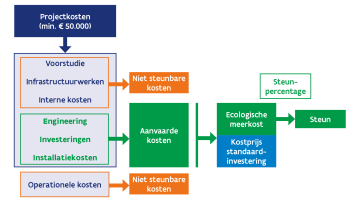What is the subsidy rate and what costs are accepted?
How much is the subsidy rate?
|
|
SME |
lare company |
|
Eco-class A |
40% |
30% |
|
Eco-class B |
30% |
20% |
A company may include multiple investments in a single project. The company can submit multiple projects. Total subsidy will be limited to €1 million per company for the entire project duration.
* Projects that achieve high cost-effectiveness (CE) (high environmental benefits per euro invested, (CE ≥ 1.5) are classed as eco-class A.
** Projects that achieve lower (but still sufficient) cost effectiveness (CE < 1.5 but > 0) are classed as eco-class B.
The eco-class classification is part of the assessment. This calculation is based on the ReCiPe Endpoint method based on an LCIA (Life Cycle Impact Analysis).
What costs are accepted?
The total project cost to realise your investment must be a minimum of 50,000 euros to be eligible. Not all costs will be accepted.

Project costs
A project must be sufficiently large in terms of investment to qualify for this call. This is determined based on the project cost. This includes all costs required to carry out the project. The combined costs for engineering, investment, installation, preliminary study, operational costs and infrastructure costs must amount to at least 50,000 euros.
Additional conditions:
- The subsidy may not be cumulated with any other government support. For this reason, the company must sign a sworn statement with the subsidy application.
- Investments must be depreciated in compliance with accounting regulations over a period of at least 3 years.
- A project may start only on the first day of the month following the month in which the subsidy application was submitted. The start date is the earliest date, either of the first invoice, of the deed upon acquisition of real estate, or of the lease agreement (see also 7.2 Start of project).
Acceptable costs
As illustrated in figure 1, accepted costs include the following components:
- Engineering costs: calculations and sizing of the chosen technology
- Investment cost: the effective cost of the new device
- Installation cost: the cost to place the installation
Only billed (external) costs are accepted in this context. Internal costs (payroll), operational costs, study costs and costs for raising buildings, foundations or other civil engineering will not be accepted.
Costs not eligible
As illustrated in figure 1, non-accepted costs include the following components:
- Preliminary study: analysis of technical and/or economic feasibility of possible technologies, impact on the environment, etc.
- Operating costs: the consumption costs of the new device (e.g., electricity, chemicals, etc.)
- Infrastructure works: cost of raising buildings, foundations, sewers, roads, etc.
Ecological investment - standard investment = ecological additional cost
Subsidy amount = ecological additional cost x subsidy percentage
The ecological additional cost
The ecological additional cost is the cost of the additional investment (excluding VAT) necessary to achieve the environmental objectives.
The additional investment is calculated by comparing the ecology investment with a conventional investment that is technically similar but does not allow for achieving the same level of environmental protection (= the standard investment). The comparison is based on equal production capacity. Furthermore, the savings and/or revenues during the first five years (updated to the European reference rate) of the useful life are deducted from the incremental cost.
